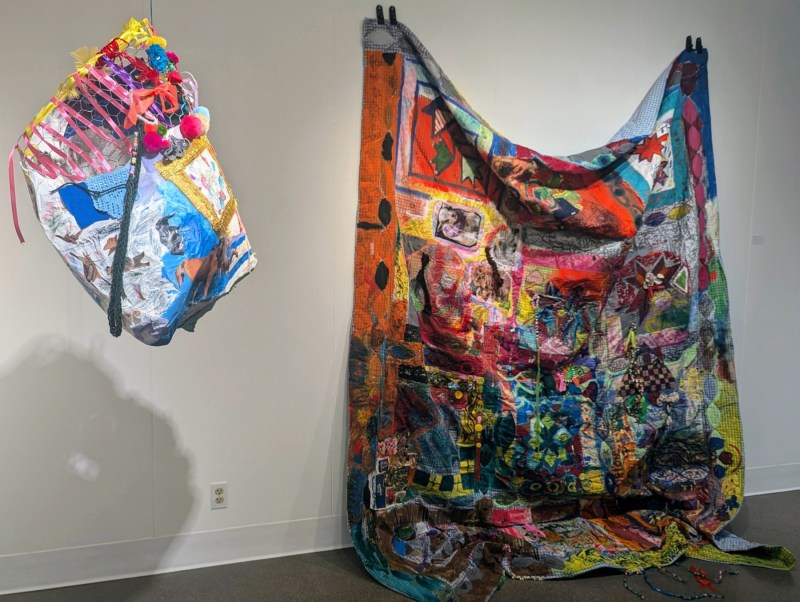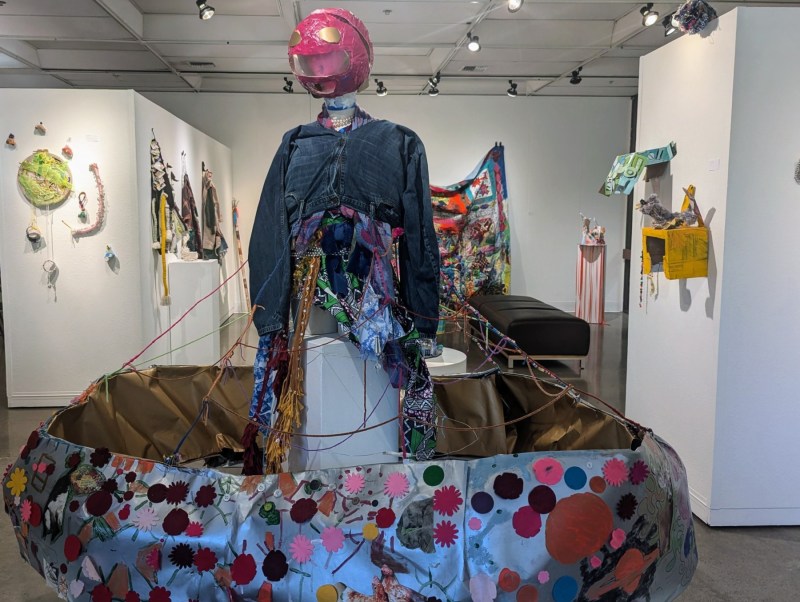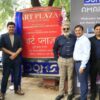
Progressive art studios – spaces for neurodivergent and disabled artists to create work – are gaining more of a foothold in the artworld. Just last fall, SF MoMA announced that it had acquired over 100 works by artists associated with the Bay Area-based studio Creative Growth, as well as two planned exhibitions of the artists’ work. Meanwhile, in Portland, two studios, Elbow Room and North Pole, continue to develop innovative programming, most recently collaborating on The Misfit Toy Show featuring works by Davis Wohlford. But not all progressive art studios are located in major cities. This fall I drove from my home in Portland toward Corvallis and took a winding side road up to Living Studios—one of two sites, the other is in Salem—in time to chat with artists and facilitators during open studio hours.
To be honest, my time learning about some of Oregon’s progressive art studios this year has left me aware of the hairy power dynamics that those who work in and with these studios must grapple with on a continual basis, as well as concern about the history of segregation perpetuated by the state that plagues this population of artists. As a journalist, I am much more interested in engaging with artists and their work than the ins and outs of a studio’s organizational structure, and so my own writing about progressive art studios leaves me with feelings of ethical unease. As I have continued my chronicling of these studios in Oregon, I have also been reminded of the oft superficial nature of equity and inclusion in the dominant contemporary art world—organizations opening their gates and tokenizing artists for the purpose of optics.
In order to ensure the continuation of art-making in the harsh economic climate of the United States, all artists need consistent infrastructure that supports both practice and professionalization—something uncommon outside of progressive art spaces and art schools. My recent visit to Living Studios revealed some aspects of progressive art studio culture that the art institutions would do well to embrace at large in this process—namely, providing ongoing resources for artists’ practices (rather than project-based funding), consistent professionalization opportunities, and platforms for showing work that do not rely on paradigms of exceptionalism and individualism.
***
Living Studios in Corvallis boasts a massive footprint including a gallery space, a large studio space for artists, and a big yard and garden. Upon entering, I was greeted by Jill Baker, an artist-in-residence and the studio’s Gallery Manager. At the time of my visit in early October, Baker was hard at work with studio artists preparing for an art show at Chemeketa Community College titled In the Garden We Will Wear Our Costumes for a Spaceship featuring “props, performances, and unusual perspectives.” Some, though not all, of the artworks I encountered at Living Studios would feature in this show.
One by one, Baker introduced me to the artists working at Living Studios. First, I met Matt Conklin, who was working on one of his signature buildings, made from acrylic paint and cardboard boxes, and covered in collages from old books and magazines. Conklin harbors a strong interest in adventure and travel, and his buildings—each several feet tall—tell a story of worldliness and exploration through their collaged imagery, featuring trains, planes, historic imagery, celebrities, and other peculiar fascinations.

Lin Musick, a Liberian American artist has most recently been working on a series of “African Dancers” in ceramic. In our conversation, I learned that Musick uses the darkest hues of clay to create these pieces. She told me a little about her childhood home in Africa, emphasizing her desire to incorporate elements of her culture into her work. She also told me about her penpal, a fellow artist in Elbow Room’s studio program in Portland.
Laura Bruyere was working on creating a mask for a Halloween costume when I spoke with her. Baker showed me several of Bruyere’s paintings and drawings on black paper, explaining that some of Bruyere’s work was recently purchased by the Hallie Ford Museum of Art’s permanent collection. We paused to take in Bruyere’s work Snow Woman together from her portfolio, a figure rendered like a snow man with three large purple buttons on its front.
At a table in the center of the workspace lay a large quilt covered in designs of paint and marker. I was told the quilt had been donated to Living Studios and the artists began coloring it bit by bit over the course of many weeks, breathing new life into its preexisting patterns and diverging to add new elements. It evolved into an emergent, collective artwork that the Living Studios artists would eventually use in performance.

Baker and I paused our studio tour to touch base with Bruce Burris, a Corvallis-based artist who helped start Living Studios in 2019 as an extension of a Community Employment Initiatives (CEI) program that he had initiated five years earlier. Burris is also presently spearheading a two-year endeavor with support from the Oregon Community Foundation that, according to the foundation website, will explore narratives from “former residents of Fairview Training Center, an Oregon institutional-residential facility that supported children and adults diagnosed with neurological differences.”
All in all, Living Studios presented a bustling environment of prolific art-making and inquiry, a place where artists can find support for their own practices as well as opportunities for collective making.
***
Baker took some time to speak with me after my tour to explain the ins and outs of the studio functions, noting that while some studios retain 501(c)3 nonprofit status in their own right, Living Studios exists as an Arts and Cultural program of Cornerstone Associates, a larger social service agency with a mission to provide opportunities for employment and community involvement for folks with intellectual and developmental disabilities. As such, those who work at and administrate Living Studios are Direct Support Professionals registered with the state with the job of providing service and support to individuals with disabilities. Baker noted that “technically” her title is “Direct Support Professional,” though the title Burris gives to every staff member he brings into Living Studios is “artist-in-residence.”
Operating within the state system for Direct Support Professionals is one option for staffing progressive art studios, but not every progressive art studio operates this way. For instance, in my writing on North Pole, I learned that its administration is not integrated with this state service.
In terms of other logistics for the creation and showcasing of artists’ work, Living Studios also provides artists with materials. “We have artist agreements with most artists so that we can show work,” said Baker. “And then it’s really complicated with sales, but a percentage goes back to the studio program of all sales and then the rest goes to the artist.”
In her view, while it may be a little bit off the beaten path, “I feel like Living Studios is part of the best art in our area.”
Baker is an artist in her own right and an instructor at Linn-Benton Community College. She brings her interest in film to her work with the artists at Living Studios. “All the artists who are involved as facilitators or staff bring their own work with them,” noted Baker. “When I’m working with an artist, you know, there’s interests that I have or connections that I see, and so I might sort of take an artist in one direction or see their work in a certain way and help nurture it in that direction.” She added, “my background is in video and so one thing that I like to do is make videos with artists at living Studios.”
***
In our conversation, Baker expressed the importance of connecting artists to professional opportunities out in the broader community, beyond the studio setting. In the Garden We Will Wear Our Costumes for a Spaceship is one such opportunity. Baker curated the show in the Gretchen Schuette Gallery at Chemeketa Community College.

Taking a tip from the Halloween season and some of the Living Studio’s artists’ work on costumes, masks, and video, the show encapsulates an alternative world, full of color, texture, and imagination. The gallery is brimming with individually and collectively made pieces, some of which also appear on a TV screen in various video compositions made by Living Studios artists.
The exhibition features Folding Quilt, the same that I had seen in-progress at the studio. It hung from a wall, eye-catching and reminiscent of the vibrant quilts by the late Pacita Abad. Around the corner of the gallery, in a viewing nook, I watched a video of some of the Living Studios artists performing with the quil, folding it together as per the title of this work, at the Benton County Historical Society Corvallis Museum.
Another collaborative endeavor—a mannequin dressed in vibrant fabrics, a pink helmet, and a large silver skirt—appeared reminiscent of a UFO, a sci-fi collage. In the exhibition video The Oh Gosh Sunshine Day UFO Encounter. Living Studios artist Laura Bruyere activated the silver skirt as she spun smilingly around in circles in a field of green grass in this video.

Many works seemed to jump out at me from the walls with Grant Pattieshaw’s woven snake and gallery ceiling where Greg Persons’s superman figure dangles on high. Among many other words, I noted one of Conklin’s vibrant towers as well as an amusing unfired ceramic work Bird in Nest by Kayla Richadson, and an elaborate weaving of fiber art by Daniel McKay.
Watching the exhibited art pieces be activated in video, in particular, left me with the feeling of world-building, the sense that these works married form and function in mysterious ways and that I was witnessing the construction of a culture made by many hands, orienting towards aesthetic stimulation and imaginative potential. Is this not the role of art in society? Some college students lingered in the gallery while I was there, chatting at the front desk. Everything and everyone had a place and a role to play, imbuing the space with an essence of belonging. The sheer number of videos and pieces kept me in the gallery far longer than expected, soaking in every little detail in the gallery’s nooks and crannies.
In my conversation with Baker, I asked if she had sensed any increased interest from contemporary art spaces to feature the work of more disabled, neurodivergent and self-taught artists in contemporary art spaces. She confirmed that she had also noted the trend. The reasons for this are undeniably hard to parse, but perhaps the surge of Disability Justice activism with the COVID-19 pandemic has shed more light on those who have historically been excluded from art spaces.
***
The recent momentum in the art world to feature artists from progressive art studios marks a move toward desegregation along the lines of so-called “disability” in the art world. Yet, disrupting the segregation of artists along the lines of Disability—in truth, a spectrum of experience that affects everyone at some point in life—is an ongoing struggle, one that requires reckoning with the effervescence of Disability at large.

For its part, Living Studios provides an example of a climate that strategically leverages resources to provide continuous support (materially and otherwise) for artists’ individual and collaborative practices. In a recent review, arts writer Ella Ray pointed toward the foregrounding of “collective authorship” in a recent Elbow Room show. The same holds true for Living Studios—the cult of the individual has no place here. Living Studios insists on creating a space oriented toward professionalization for working artists and seemingly resisting the pall of dehumanization that can come with cut and dry social services. And, as exemplified by my exchanges with Baker and Burris, all these measures necessitate incredible sensitivity from administrators toward nuanced power differentials. Arguably, this tenet of operation is most lacking in the greater contemporary art world.
Utopia is a myth, but Living Studios’ capacity to both acknowledge and operate within available systems with sensitivity makes for a generative space of change with vibrations outward. The question remains: Will the overall movement to platform the work of artists from progressive art studios beget necessary culture shifts within the dominant culture of the contemporary art world? This remains an open question.
***
In the Garden We Will Wear Our Costumes for a Spaceship is on view at Chemeketa Community College’s Gretchen Schuette Gallery from November 6 – December 6. Open hours are Fall Term Gallery Hours are Monday 8 am-5 pm, Tuesday 10 am-5 pm, Wednesday 8 am-3 pm, Thursday 10 am-5 pm, and Friday 8 am-5 pm. More information about Living Studios Gallery is available here.
Photo credit: Jo Silver










